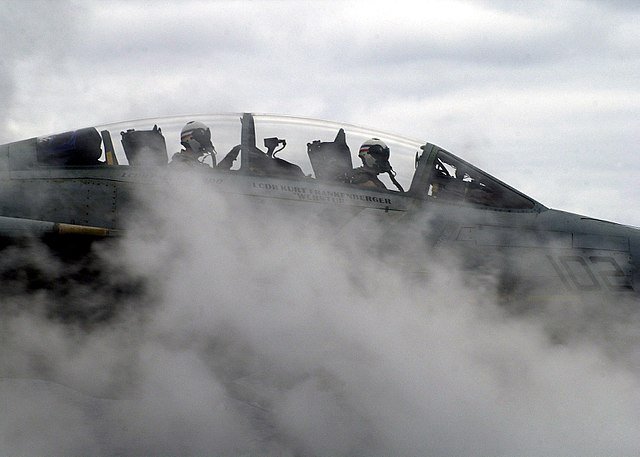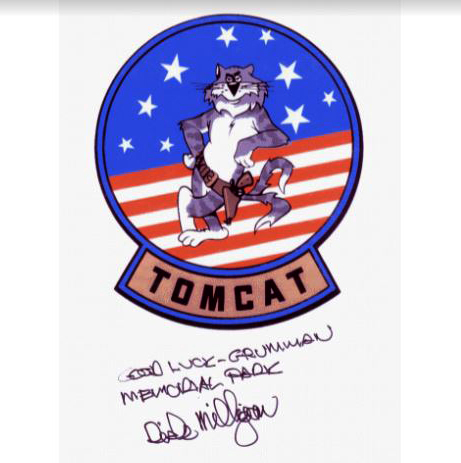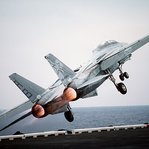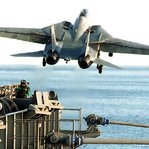One of the most famous and recognizable American fighter jets has got to be the F-14 Tomcat. Featured in the classic movie Top Gun and serving 36 years in the Navy protecting the United States, this powerhouse of a plane is still missed by airpower affecianos and the pilots and Radar Intercept Officers (RIO) - the flight officers in the aft seat of the jet - who flew it.
We enlisted the help of the Cradle of Aviation Museum curator, Joshua Stoff, and the F-14 Tomcat Association historian, Willian Barto, to provide us with some great F-14 stories and vet our Tomcat facts! (These two know their stuff when it comes to F-14 and Long Island aviation history.)
Read about five times Long Island made aviation history here.
Below we present some historical and crazy facts about the F-14 Tomcat fighter jet.
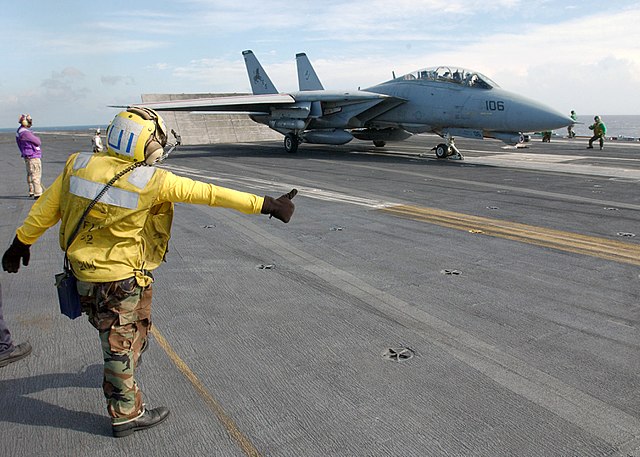
At sea aboard USS Theodore Roosevelt (CVN 71) Dec. 11, 2002 -- A plane director positions an F-14 “Tomcat” assigned to the "Black Lions" of Fighter Squadron Two One Three (VF-213) into launch position on one of four steam driven catapults on the ship’s flight deck. Roosevelt and her embarked Carrier Air Wing Eight (CVW-8) are underway for Tailored Ship Training Availability (TSTA). U.S. Navy photo by Photographer’s Mate 2nd Class James K. McNeil. Date: 11 December 2002. Photo: U.S. Navy photo by Photographer’s Mate 2nd Class James K. McNeil. / Public domain.
Specs
- The F-14 is a two-seat, twin-engine jet fighter
- It was the first U.S. jet fighter with twin tails, a distinctive feature
- The wings sweep for optimal performance depending on speed and altitude
- The wingspan of the F-14 is 64 feet forward swept and 38 feet fully swept
- The aircraft is over 62 feet long
- An F-14 can reach an altitude of more than 56,000 feet
- Its systems could track 24 enemy aircraft as far away as 195 miles
- The original life of a F-14 was 6,000 hours of flying time but was later extended to 7,200 hours
- The cost per unit for an F-14 was $38 million (airframe and powerplant only)
- The F-14 could reach speeds of Mach 2+
- The F-14 could carry up to 6 Phoenix, or 6 Sparrow and 2 Sidewinder air-to-air missiles
- A complement of six Phoenix missiles (radar-guided air-to-air missiles) was dubbed “The John Wayne Loadout”
- F-14s could refuel in flight
- The F-14 came in three models - the A, B, and D
- The F-14A was the original model
- The F-14B and F-14D both represented upgrades to the original
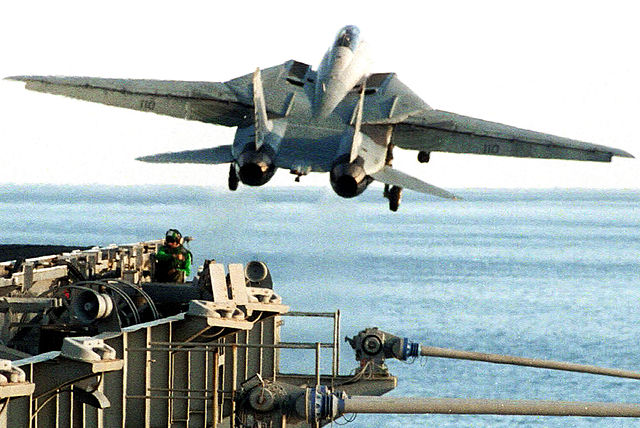
Photo: U.S. Navy photo by Photographer’s Mate 2nd Class Jason Scarborough. / Public domain
History
- The F-14 was developed to replace the F-4 Phantom fighter in the 1960s
- Before the F-14, Grumman was testing the F-111B, a Navy version of the General Dynamics
- F-111A but it proved to be an inferior aircraft
- Grumman had in mind an alternative design, and the Navy gave the go ahead for 12 preproduction aircraft.
- The designs went through 9,000 hours of wind-tunnel testing on about 2,000 different configurations of the jet.
- The F-14 first flew on December 21, 1970 in Grumman’s facility in Calverton
- Initial testing of the fighter was done at Calverton and flight tested over Long Island Sound.
- The pilot was Grumman Chief test pilot Robert Smythe
- Test pilot William Miller rode in the back seat
- A second test flight on December 30 resulted in the loss of the aircraft due to failure of a hydraulic pump resulting in a loss of flight control
- The crew ejected safely, and the aircraft crashed
Watch a video of that test flight and crash below
- It was first deployed in 1974 with the U.S. Navy aboard USS Enterprise (CVN-65)
- The F-14 took part in air cover for the Evacuation of Saigon, Vietnam and saw action in many major skirmishes including Libya, Bosnia, Iraq, Afghanistan and during the Cold War
- In the late 1970s Iran ordered 80 jets, but only secured the delivery of 79 F-14’s from the US government to gain air superiority over Soviet MiG fighters before the 1979 revolution
- F-14s would intercept Soviet bombers that got too close to a US carrier group and escort them away from our forces
- During the first Gulf of Sidra incident in 1981 F-14 Tomcats of VF-41 Black Aces aboard USS Nimitz shot down two Libyan Su-22 aircraft
- In 1989, during the second Gulf of Sidra incident, two Tomcats from the VF-32 “Swordsmen” aboard USS John F. Kennedy shot down two Libyan MiG-23s
- In total, 712 F-14 Tomcats were built. (632 for the USN and 80 for Iran)
- After it was retired the US destroyed its stockpile of F-14’s to avoid having parts get into the hands of Iran whose fleet is aging and decrepit. Several jets survived and are in museums today
- The F-14 has been replaced in service on Navy aircraft carriers by the Boeing F/A-18E/F Super Hornet and the Lockheed Martin F-35C Joint Strike Fighter (JSF)

A U.S. Navy Grumman F-14A Tomcat of Fighter Squadron 33 (VF-33) "Starfighters" is launched from the aircraft carrier USS Theodore Roosevelt (CVN-71) in the Atlantic Ocean on 30 September 1987. VF-33 was assigned to Carrier Air Wing 1 (CVW-1) aboard the USS America (CV-66). In 1987, CVW-1 was regularly deployed aboard the newly commissioned Theodore Roosevelt, as America was in overhaul at the Norfolk Naval Shipyard, Virginia (USA), Date: Between 20 November 1986 and 11 February 1988. Photo: PH1 Gerwien, U.S. Navy / Public domain.
The nickname - Tomcat
- All Grumman fighters were named after cats beginning with Wildcat, Hellcat, etc.
- The F-14 is named after two Admirals who championed the design after the F-111B (the Navy version of General Dynamics F-111A) failed
- The nickname Tomcat was inspired by Admiral Thomas H. Moorer, Chief of the Joint Chiefs of Staff, and Admiral Thomas F. Connolly Chief of Naval Operations, two of the major supporters of the F-14 within the Navy
- While landing, the F-14 had a lot of parts that moved around like its flaps, rudders, brakes, spoilers and stabilizers earning it another nickname, Turkey, because of the “flapping” of all those parts when it landed
F-14 Tomcat logo created by Dick Milligan. Signed by Milligan. Photo: Provided by Willian Barto.
The famous Tomcat logo
- Jim Rodriguez from Grumman’s Presentations Department went out to find the perfect cat to use as a model for their inspiration
- He searched around and ended up photographing a mackerel tabby that he found in the parking lot of a Bayshore animal pound
- Rodriguez went through multiple iterations but did not hit on the right look
- Dick Milligan, another employee in the Grumman Presentations Department ended up drawing the final cartoon illustration that we know today
- Milligan said that the idea for the logo was to find a simple tomcat with a "smart aleck" face
- According to Rodriguez, the "Anytime Baby" slogan came about as a challenge to the U.S. Air Force F-15 Eagle
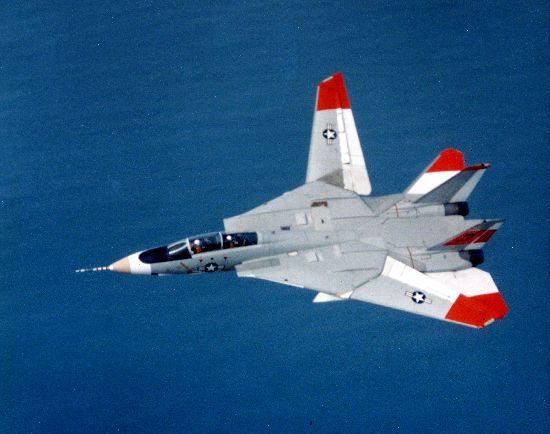
F-14 Tomcat with wings showing asymmetric sweep. Photo: SDASM / Public domain
Cool stuff
- There is an interactive Google map that shows where all of the F-14 have gone
- May 13 is Top Gun Day and there is a website that will tell you all about how to celebrate
- The last American F-14 to fly is slated to go to the Cradle of Aviation Museum
- The F-14 was famously featured in the megahit Top Gun starring Tom Cruise
- After Top Gun, the F-14 was also featured in a series of video games
- Tom Cruise was reunited with the F-14 Tomcat for the filming of the Top Gun sequel
- There is a web page that tells you all the US squadrons that flew F-14 Tomcats from 1970, initial Grumman test flights, to 2006, when it was retired
- Want to visit all the F-14 Tomcats on display? Check this list here
- The F-14’s variable sweep wing was inspired by Mother Nature, and the flight of birds
- There was a Tomcat that once sported the Playboy Bunny logo on its tail
- The asymmetrical wing sweep of the F-14 was thought to be impossible (one wing tucked with the other wing extended during flight) by engineers. This was disproved by test pilots










